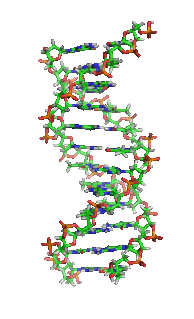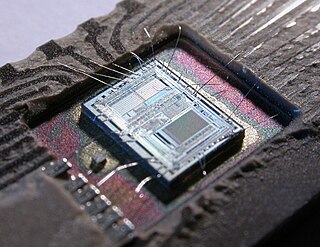Related Research Articles

Electronics comprises the physics, engineering, technology and applications that deal with the emission, flow and control of electrons in vacuum and matter. This distinguishes it from classical electrical engineering as it uses active devices to control electron flow by amplification and rectification rather than just using passive effects such as resistance, capacitance and inductance.
A logic gate is an idealized or physical electronic device implementing a Boolean function, a logical operation performed on one or more binary inputs that produces a single binary output. Depending on the context, the term may refer to an ideal logic gate, one that has for instance zero rise time and unlimited fan-out, or it may refer to a non-ideal physical device.

Digital electronics is a field of electronics involving the study of digital signals and the engineering of devices that use or produce them. This is in contrast to analog electronics and analog signals.
Transistor–transistor logic (TTL) is a logic family built from bipolar junction transistors. Its name signifies that transistors perform both the logic function and the amplifying function ; it is the same naming convention used in resistor–transistor logic (RTL) and diode–transistor logic (DTL).

DNA computing is an emerging branch of computing which uses DNA, biochemistry, and molecular biology hardware, instead of the traditional silicon-based computer technologies. Research and development in this area concerns theory, experiments, and applications of DNA computing. Although the field originally started with the demonstration of a computing application by Len Adleman in 1994, it has now been expanded to several other avenues such as the development of storage technologies, nanoscale imaging modalities, synthetic controllers and reaction networks, etc.

Theoretical computer science (TCS) is a subset of general computer science and mathematics that focuses on more mathematical topics of computing and includes the theory of computation.
Resistor–transistor logic (RTL) is a class of digital circuits built using resistors as the input network and bipolar junction transistors (BJTs) as switching devices. RTL is the earliest class of transistorized digital logic circuit used; other classes include diode–transistor logic (DTL) and transistor–transistor logic (TTL). RTL circuits were first constructed with discrete components, but in 1961 it became the first digital logic family to be produced as a monolithic integrated circuit. RTL integrated circuits were used in the Apollo Guidance Computer, whose design was begun in 1961 and which first flew in 1966.
Reading is an action performed by computers, to acquire data from a source and place it into their volatile memory for processing. Computers may read information from a variety of sources, such as magnetic storage, the Internet, or audio and video input ports. Reading is one of the core functions of a Turing machine.

Andrew (Drew) David Endy is a synthetic biologist and Tenured Professor of bioengineering at Stanford University, California.

A wetware computer is an organic computer composed of organic material such as living neurons. Wetware computers composed of neurons are different than conventional computers because they are thought to be capable in a way of "thinking for themselves", because of the dynamic nature of neurons. While wetware is still largely conceptual, there has been limited success with construction and prototyping, which has acted as a proof of the concept's realistic application to computing in the future. The most notable prototypes have stemmed from the research completed by biological engineer William Ditto during his time at the Georgia Institute of Technology. His work constructing a simple neurocomputer capable of basic addition from leech neurons in 1999 was a significant discovery for the concept. This research acted as a primary example driving interest in the creation of these artificially constructed, but still organic brains.
Optical or photonic computing uses photons produced by lasers or diodes for computation. For decades, photons have promised to allow a higher bandwidth than the electrons used in conventional computers.

Diode logic (DL), or diode-resistor logic (DRL), is the construction of Boolean logic gates from diodes. Diode logic was used extensively in the construction of early computers, where semiconductor diodes could replace bulky and costly active vacuum tube elements. The most common use for diode logic is in diode–transistor logic (DTL) integrated circuits that, in addition to diodes, include inverter logic for power gain and signal restoration.

Integrated injection logic (IIL, I2L, or I2L) is a class of digital circuits built with multiple collector bipolar junction transistors (BJT). When introduced it had speed comparable to TTL yet was almost as low power as CMOS, making it ideal for use in VLSI (and larger) integrated circuits. The gates can be made smaller with this logic family than with CMOS because complementary transistors are not needed. Although the logic voltage levels are very close (High: 0.7V, Low: 0.2V), I2L has high noise immunity because it operates by current instead of voltage. I2L was developed in 1971 by Siegfried K. Wiedmann and Horst H. Berger who originally called it merged-transistor logic (MTL). A disadvantage of this logic family is that the gates draw power when not switching unlike with CMOS.
A chemical computer, also called a reaction-diffusion computer, Belousov–Zhabotinsky (BZ) computer, or gooware computer, is an unconventional computer based on a semi-solid chemical "soup" where data are represented by varying concentrations of chemicals. The computations are performed by naturally occurring chemical reactions.
A computer is a machine that can be instructed to carry out sequences of arithmetic or logical operations automatically via computer programming. Modern computers have the ability to follow generalized sets of operations, called programs. These programs enable computers to perform an extremely wide range of tasks. A "complete" computer including the hardware, the operating system, and peripheral equipment required and used for "full" operation can be referred to as a computer system. This term may as well be used for a group of computers that are connected and work together, in particular a computer network or computer cluster.

An electronic circuit is composed of individual electronic components, such as resistors, transistors, capacitors, inductors and diodes, connected by conductive wires or traces through which electric current can flow. To be referred to as electronic, rather than electrical, generally at least one active component must be present. The combination of components and wires allows various simple and complex operations to be performed: signals can be amplified, computations can be performed, and data can be moved from one place to another.
Bio computers use systems of biologically derived molecules—such as DNA and proteins—to perform computational calculations involving storing, retrieving, and processing data.

Creating a cellular model has been a particularly challenging task of systems biology and mathematical biology. It involves developing efficient algorithms, data structures, visualization and communication tools to orchestrate the integration of large quantities of biological data with the goal of computer modeling.
An optical transistor, also known as an optical switch or a light valve, is a device that switches or amplifies optical signals. Light occurring on an optical transistor’s input changes the intensity of light emitted from the transistor’s output while output power is supplied by an additional optical source. Since the input signal intensity may be weaker than that of the source, an optical transistor amplifies the optical signal. The device is the optical analog of the electronic transistor that forms the basis of modern electronic devices. Optical transistors provide a means to control light using only light and has applications in optical computing and fiber-optic communication networks. Such technology has the potential to exceed the speed of electronics, while saving more power.

The memory cell is the fundamental building block of computer memory. The memory cell is an electronic circuit that stores one bit of binary information and it must be set to store a logic 1 and reset to store a logic 0. Its value is maintained/stored until it is changed by the set/reset process. The value in the memory cell can be accessed by reading it.
References
- 1 2 3 4 5 6 7 Sebastein Anthony (March 29, 2013). "Stanford creates biological transistors, the final step towards computers inside living cells". Extreme Tech. Retrieved March 29, 2013.
- 1 2 3 4 5 6 Robert T. Gonzalez (March 29, 2013). "This new discovery will finally allow us to build biological computers". IO9. Retrieved March 29, 2013.
- 1 2 3 Jerome Bonnet; Peter Yin; Monica E. Ortiz; Pakpoom Subsoontorn; Drew Endy (March 28, 2013). "Amplifying Genetic Logic Gates". Science. 340 (6132): 599–603. Bibcode:2013Sci...340..599B. doi:10.1126/science.1232758. PMID 23539178.
- 1 2 3 Lisa M. Krieger (March 29, 2013). "Biological computer created at Stanford". San Jose Mercury News. Retrieved March 29, 2013.
- ↑ Katherine Bourzac (March 28, 2013). "How to Make a Computer From a Living Cell". MIT Technology Review. Mashable. Retrieved March 30, 2013.